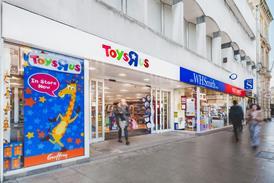A consortium of some of the country’s top retailers and landlords has produced guidelines for landlords laying out ways they can cut retailers’ service charge bills by up to 20 per cent.
The group, which is headed up by Arcadia property director Chris Harris and Land Securities’ managing director Richard Akers, has said that both sides need to take a “new perspective” on the way service charges are approached.
The advice came as part of a four month study by the group into the ways that service charge costs can be reduced. Four major shopping centres were included in a pilot scheme that also drew on feedback from retailers to find out how reductions could be made.
All the centres involved in the scheme managed to make cuts of between 10 and 20 per cent.
Landlords were not matching retailers’ commitments to cost reduction when the downturn hit, said Harris, who described a “disconnect” between the industries before the working group was formed.
Speaking to Retail Week, he said: “I think what was happening six months ago was that retailers were much more focused on costs in line with what was going on. It was quite eye-catching at the time to see what was happening in retail organisations but service charge costs were still going up in line with RPI.”
The group also includes New Look and Next and landlords Liberty International, Prupim, British Land, Westfield, Capital & Regional and Legal & General.
It has produced a 10-point plan [see below], which addresses every aspect of service charge management with practical recommendations for landlords to adopt.
The 10-point plan
1) Engagement with Retailers
- Discuss and agree with a representative group of retailers what level of service they require or consider appropriate in the current economic climate.
- Solicit greater support for initiatives such as recycling that require retailer participation by communicating to them the direct cost benefit.
- Investigate potential economies of scale from sharing service providers and/or suppliers.
- Obtain retailer feedback on the success that marketing and events activity has had on their sales and encourage more collaborative working.
2) Hours of Operation
- Review centre trading and operating hours to achieve the optimal balance between opportunities for retailers to maximise sales and the avoidance of unnecessary running costs.
- Evaluate the ability and benefit of switching late night or overnight activities such as cleaning or maintenance to day time or evening.
- Review access and delivery periods so that service yards and back of house areas are not illuminated for unnecessarily long periods.
3) Cleaning and environment
- Review opportunities to reduce the frequency of periodical cleaning such as high level, escalators, windows, etc.
- Evaluate the cost/benefit of shifting to flexible staff contracts.
- Review contract overhead and profit elements and evaluate opportunities to renegotiate given current market opportunities.
- Evaluate opportunities to reduce the frequency and scope of landscaping contracts.
4) Waste management
- Review waste management strategy and evaluate opportunities for reducing, reusing and recycling.
- Review the variety of waste streams that are recycled to minimise landfill costs, such as polythene, metal, plastic and glass, as well as cardboard
- Review contract overhead and profit elements and evaluate opportunities to renegotiate given current market opportunities.
5) Security
- Review opportunities for multitasking security staff with customer service and cleaning duties.
- Evaluate the cost/benefit of shifting to flexible staff contracts.
- Review contract overhead and profit elements and evaluate opportunities to renegotiate given current market opportunities.
6) Administration, Procurement and Purchasing
- Re-negotiate and/or re-tender existing service and supply contracts to take advantage of current market conditions.
- Evaluate existing procurement methods against emerging alternatives such as “e-auction”, etc.
- Explore opportunities to maximise economies of scale benefits from centralised portfolio procurement, through collaboration with other landlords, retailers, etc.
- Review control measures in place to avoid unnecessary wastage or stock loss or supplies.
- Evaluate the benefits of staff reward schemes which encourage staff from all levels to identify efficiency improvements and sustainable cost savings.
7) Plant and Fabric Maintenance
- Review the specification and frequency of maintenance carried out on non essential equipment and consider whether expenditure on major projects can be delayed, (acknowledging that this may simply defer or increase expenditure to future years), but whilst ensuring health and safety and statutory compliance are not compromised;
- Review opportunities for the upgrade/replacement of plant and equipment to deliver operating cost efficiencies. Introduction of such initiatives should include early communication and will require collaboration with retailers.
8) Utilities and Energy Management
- Evaluate effectiveness of existing energy procurement strategy.
- Review mall heating and cooling settings and consider the case for converting to natural ventilation.
- Evaluate opportunities to reconfigure the Building Management System to minimise operating times of plant, equipment and lighting.
- Evaluate opportunities to switch to low energy fittings and lamps and engender a “switch off” culture when not in use
- Review opportunities to isolate sections of car parks in quiet periods and cut light levels to those areas.
9) Customer Services
- Evaluate opportunities to reduce the extent of customer service facilities such as information desks, customer service staff, leaflets, site maps, etc.
- Evaluate the effectiveness of the existing customer service roster and/or explore opportunities to utilise customer service staff for other roles during quiet periods.
- Explore opportunities to utilise third parties to provide services such as shop-mobility at no cost to the centre.
10) Marketing
- Review the centre’s catchment area and the demographics within it. Segment the audience demographically and deliver targeted offers to the appropriate customers;
- Look to liaise with retailers to optimise joint marketing opportunities.
- Concentrate on the most cost effective communications mediums - PR and digital activity;
- Undertake campaigns that deliver obvious returns on investment through data capture and voucher redemption.

























No comments yet